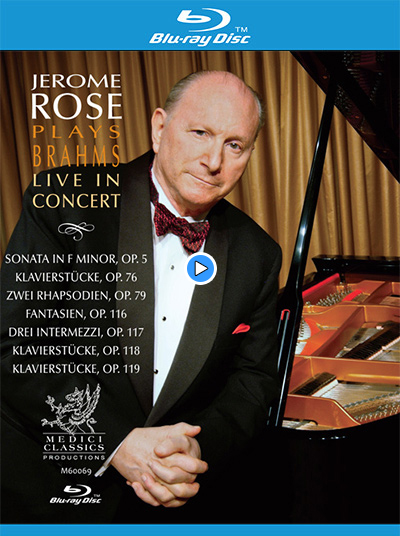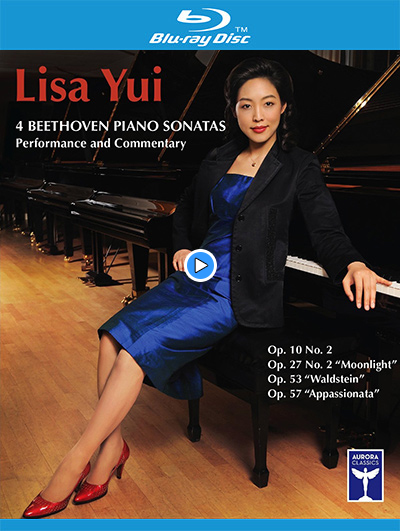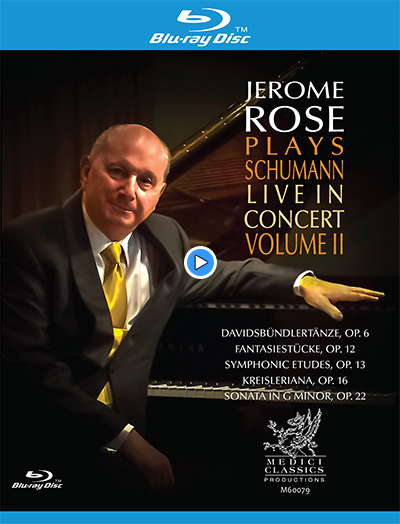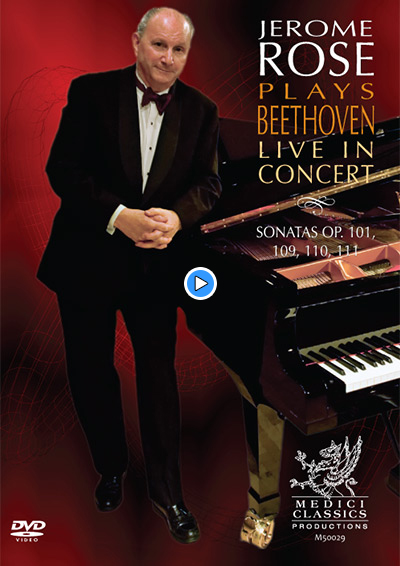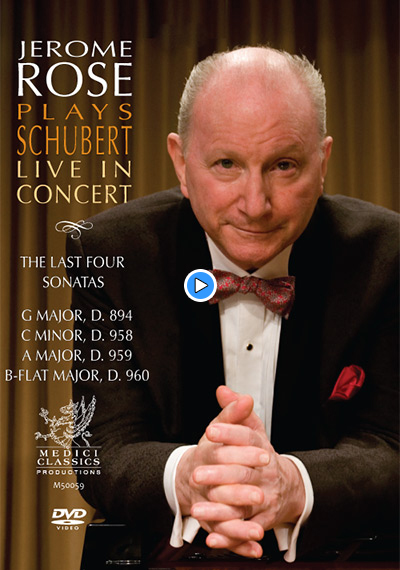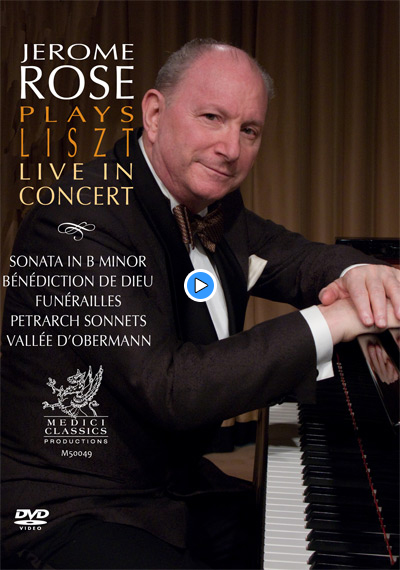Videographer and Video Editor in New York City
Videographer and Video Editor in New York City
in New York City
in New York City
Video Editor
in New York City
You can feel with every note and every filmed portrait of the pianist as much a spiritual connection between Brahms and Jerome Rose. He was very closely associated with this music, the 74-year-old says in a monologue about Brahms in the appendix. Since his first encounter with the piano music of Brahms - it was that time again, the Handel Variations - he had his refined knowledge of this music continues. It was he also realized that from the keyboard works even Brahms's great knowledge of the works of Richard Wagner was editorial.
While working on the Piano Pieces Op 76, Brahms worked intensively with Chopin and this series would have an unmistakable connection to the Violin Concerto and the violin sonatas. Very vigorous and determined Rose designed the chordal interval jumps at the beginning of the Piano Sonata No. 3, Op 5 and reconciles with a gradual relaxation to the secondary theme. Especially in this early work, which rose as a study for the feels great symphonic works, he lays it on extreme contrasts, without causing breaks occur. Sometimes he lifts his left hand at crescendos more prominent than the right, as if to emphasize the phrase with a thick marker. Even in the finale of the Piano Sonata or the "Two Rhapsodies," Op 79 he produced exciting soft contours with the capricious parts of contrasting works. The Moderato semplice the Intermezzi Op 117, it gives a grandeur that almost resembles Liszt.
The camera angles are often placed crosswise, sometimes the images are superimposed for seconds or blur together impressively. Then suddenly opens up a diamond, which superimposes the frontal view of the pianist, or the picture is divided into two and you can see Rose side by side from the side and from the front.
PianoNews
Musicologist (her doctoral degree is on the Belgian pianist Marie Pleyel) and renowned professor (she notably directs a series of concerts "The Lives of the Piano" in Manhattan, as well as a series of lecture-concerts, "Beethoven at Yamaha") the Japanese-Canadian pianist Lisa Yui offers us outstanding interpretations and presentations of these sonatas.
A disciple of Oxana Yablonskaya, Byron Janis and Marc Silverman, among others, she led the piano department in the music advancement program at the Juilliard School. In Blu-ray, these performances, which were recorded in New York, immediately strike you with their clarity of articulation, the flexibility of the notes. Here is the kind of relaxation which Aldo Ciccolini stated is the prelude to all interpretation. With simple gestures, she clearly reveals the polyphony but with an overall dramatic sense (sonatas "Moonlight" and "Appassionata"). No phrase is aggressive, and this classical lyricism, anti-theatrical almost, is as effective as it is musical.
Those who wish to learn more about these works will find included in this video precious help in the commentary (in fluent English). We note the excellence of the sound and image.
There is nothing worse than over-excitable, overinterpreted Schumann, so it comes as something of a relief to encounter this second volume of favourite works from Jerome Rose, who absorbs the composer's free-flowing imagination into compelling musical paragraphs. Even when the flights of fancy come thick and fast, as in Davidsbündlertänze, one is left with the sensationof supreme logic binding everything together.
In the Op 12 Fantasiestücke, not a single ugly note is sounded. No matter how awkward and fatiguing Schumann's figurations - most infamously in Traumes Wirren - Rose maintains a remarkably relaxed action, so that at times it looks as if he is merely flopping his fingers gently onto the keys and somehow sounding the right notes.
Not surprisingly, the Etudes symphoniques (without the posthumous numbers) respond particularly well to his ability to sustain the long line that underpins the whole structure. Without resorting to extremes of dynamic or articulation,this is a reading that emphasises the 'symphonic' rather than the 'etude'. However, there are technical triumphs along the way too, not least in Etude 10, where Rose manages to despatch the toccata-like figurations against continuously sounded dotted rhythms without using the sustaining pedal.
Kreisleriana is another magisterial conception that refreshingly avoids outbursts of mannered interpretative rhetoric, yet it is the Second Sonata that really lifts the roof off, with its combination of high-velocity agility and velvety sonorities. The recording and pin-sharp picture quality capture Rose's effortless playing to perfection, and the direction rightly focuses our attention on where it needs to be - those amazing hands.
International Piano
A concert is a concert. Quintessential for our judgement is, what, how and by whom we hear it. In a film, however, the visual presentation additionally guides our attention. Therefore, the director for "Jerome Rose Plays Beethoven Live in Concert" came up with something inventive.
The spatial variability of camera positions was very restricted in the small hall of Yamaha Artists Services in New York. In order not to stay in a dull atmosphere of bleak documentation, four standard perspectives – frontal, sideways from the pianist, as well as sideways and from above the stage - are used in fast, smooth cuts. That's why Jerome Rose appears quite relaxed while playing the Sonata Op. 101; his interpretation is guided by inner composure. Especially concerning the sound, the dissonances have, as in Sonata Op. 109, a clear function, and they are not retouched by him.
The optic presentation changes for the Adagio of the Sonata Op. 110 as the picture is cut into four simultaneous images. That way, one isn't drawn into the music so much, but rather has a certain distance to Jerome Rose's introverted emotional facets through the movement of one's eyes. Since such splitting of images is just one option of the camera direction and used often, the perception of Sonata Op. 111 with its dark appassionato becomes a more relaxed viewing pleasure.
So this production shows both Jerome Rose as a subtle Beethoven interpreter, and also a film concept by which the listening/viewing of piano music gets an aesthetic justification.
Last year Jerome Rose excited music lovers worldwide with live recordings on four DVDs, recorded at a small auditorium at Yamaha in New York. The simple visual presentation with occasional split screens and cross-fading is entirely focused on interpretation, so that the playing of the pianist is documented directly and without distracting side effects.
The series that started off with works by Beethoven, Schumann, Chopin and Liszt is now continued by the pianist with the four last Schubert Sonatas on the same high level and in the same modest, but by no means unappealing, setting. Rose's Interpretations of Schubert are of formidable caliber, both in terms of mental penetration and competent technical handling.
As in the last recordings, the pianist's enormous concentration and artistic calmness is fascinating. True mastery, only scarcely found today, consists of the balance of architectonic awareness, creativity in sound, and seemingly spontaneous phrasing.
Through this balance of artistry, Rose's interpretations attain something timeless and exemplary. He is able to unite that peculiar change in Schubert's music from painful longing to bittersweet solace into a strong unison, for example in the subtle cantilena in the second movement of the A Major Sonata.
One hopes that the series of live recordings by this eminent artist will be continued.
FonoForum
In the fourth of his "Live in Concert" DVD series, Jerome Rose performs Liszt's monumental Sonata in B minor, the "Petrarch Sonnets", Bénédiction de Dieu dans la solitude", "Funérailles", and "Vallée d'Obermann" before an intimate audience at Yamaha Artist Services hall in New York.
Rose brings to the stage an impressive and engaging technical display, captured in superb visual clarity in this four-camera, professionally produced DVD.
The bonus features of the DVD include his equally satisfying 1975 BBC performances of "Au bord d'une source", "Orage", and "Les Cloches de Genève"
Clavier Companion
Jerome Rose is respectful when he talks about Leonard Shure and Rudolf Serkin, with whom he studied in the USA. In his commemoration he calls these two outstanding piano teachers of the 20th Century his mentors who fundamentally inspired him in his concept of interpreting the last four sonatas of Franz Schubert. His key to these monumental works is the knowledge that Franz Schubert’s style of composing is autobiographically introspective and aesthetically defined by vocal perspective.
What Jerome Rose talks about in his “Notes on Schubert” is reflected in his recordings made in the small hall of Yamaha Artist Services in New York. The Cantabile of the G Major Sonata is heard in short sighs showing how Jerome Rose understands its structure as small breathing movements. He contrasts the dramatic demonstration of the C minor Sonata and its song of futile love with a relaxed joy in the Allegro. The epic breadth in the Allegro of the A Major Sonata turns into an intimate nocturne in the Andantino. The stringently philosophical discourse, with which the B Flat Major Sonata begins, frees itself through contemplation to the elixir of life.
These qualities of interpretation are by all means visible, because the cameras do not focus only in a stationary way on his fingers, but also observe him with slow zooms and soft angle changes. Sometimes, the direction is further loosened with images split into two or even four screens, making Jerome Rose’s fully matured interpretations a visual pleasure as well.
PianoNews
The split-screen (the screen divided into many parts, up to four here) permits one to see a feature from many angles at one time, as in a Brian de Palma film, creating a form of suspense. But rest assured that the pianist survives at the end.
The left hand of Jerome Rose is particularly powerful (Funérailles), the line in the right very flexible and he captivates from beginning to end in the Benediction de Dieu dans la solitude, a work often played with compunction that here is formidably living and radiant.
The BBC archival images from the 70's let us see other playing that is much more external, with a winged virtuosity like Cziffra, in excerpts from the Années de Pèlerinage.
66 Overlook Terrace #3E, New York, NY 10040
Studio: (646) 505-0706 | Mobile: (917) 715-8755 | Email: asafblasberg@outlook.com | Top of Page↑
66 Overlook Terrace #3E
New York, NY 10040
Studio: (646) 505-0706
Mobile: (917) 715-8755
Email: asafblasberg@outlook.com
Top of Page↑
66 Overlook Terrace #3E
New York, NY 10040
Studio: (646) 505-0706
Mobile: (917) 715-8755
Email: asafblasberg@outlook.com
Top of Page↑
